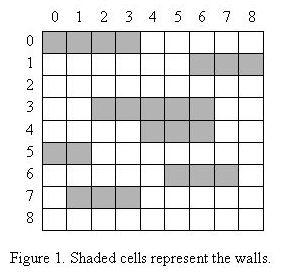Pass-Muraille
Time Limit: 1000MS Memory Limit: 65536K
Total Submissions: 13172 Accepted: 4178
Description
In modern day magic shows, passing through walls is very popular in which a magician performer passes through several walls in a predesigned stage show. The wall-passer (Pass-Muraille) has a limited wall-passing energy to pass through at most k walls in each wall-passing show. The walls are placed on a grid-like area. An example is shown in Figure 1, where the land is viewed from above. All the walls have unit widths, but different lengths. You may assume that no grid cell belongs to two or more walls. A spectator chooses a column of the grid. Our wall-passer starts from the upper side of the grid and walks along the entire column, passing through every wall in his way to get to the lower side of the grid. If he faces more than k walls when he tries to walk along a column, he would fail presenting a good show. For example, in the wall configuration shown in Figure 1, a wall-passer with k = 3 can pass from the upper side to the lower side choosing any column except column 6.
Given a wall-passer with a given energy and a show stage, we want to remove the minimum number of walls from the stage so that our performer can pass through all the walls at any column chosen by spectators.

Input
The first line of the input file contains a single integer t (1 <= t <= 10), the number of test cases, followed by the input data for each test case. The first line of each test case contains two integers n (1 <= n <= 100), the number of walls, and k (0 <= k <= 100), the maximum number of walls that the wall-passer can pass through, respectively. After the first line, there are n lines each containing two (x, y) pairs representing coordinates of the two endpoints of a wall. Coordinates are non-negative integers less than or equal to 100. The upper-left of the grid is assumed to have coordinates (0, 0). The second sample test case below corresponds to the land given in Figure 1.
Output
There should be one line per test case containing an integer number which is the minimum number of walls to be removed such that the wall-passer can pass through walls starting from any column on the upper side.
Sample Input
2
3 1
2 0 4 0
0 1 1 1
1 2 2 2
7 3
0 0 3 0
6 1 8 1
2 3 6 3
4 4 6 4
0 5 1 5
5 6 7 6
1 7 3 7
Sample Output
1
1
题目有点坑。有对输入以下两个情况:
1、第一个输入的不一定是左端点
2、同一层纵坐标可以有多面墙。//体现在输出中的不同行可以对应相同的纵坐标
思想:贪心从左到右扫,对每一列进行遍历。选择最长的墙删除。细节见下代码,相关注释已经给出(参考了某位大佬给的思想)。
#include<iostream>
#include<cstring>
#include<cstdio>
#include<algorithm>
using namespace std;
const int N=105;
int dp[N][N];
int main(){
int t;
scanf("%d",&t);
while(t--){
memset(dp,0,sizeof(dp));
int m,n;
scanf("%d%d",&m,&n);//m为墙数,n为可穿过的最大墙数
int x=0,y=0;
for(int i=0;i<m;i++){
int x1,y1,x2,y2;
scanf("%d%d%d%d",&x1,&y1,&x2,&y2);
x=max(x,max(x1,x2)); //最大的x :遍历区域
y=max(y,y1);//最大的y :遍历区域
int len;
len=max(x1,x2)-min(x1,x2)+1;//墙的长度 :方便处理同一纵坐标有任意面墙的情况
for(int j=min(x1,x2);j<=max(x1,x2);j++){
dp[y1][j]=max(dp[y1][j],len--);//有墙的就标记,数据代表其后面还占据的方格数
}
}
int ans=0;
for(int i=0;i<=x;i++){
int cnt=0;
for(int j=0;j<=y;j++){
if(dp[j][i])
cnt++;//有墙的就记录
}
while(cnt>n){//直到这一列可以穿过
int pos=0,maxx=0;
for(int j=0;j<=y;j++){
if(maxx<dp[j][i]){
maxx=dp[j][i];
pos=j;//记录纵坐标
}
}
int p=dp[pos][i];
for(int j=0;j<p;j++)
dp[pos][i+j]=0;//清空
cnt--;//清空后数减1
ans++;//记录我们的操作数
}
}
printf("%d\n",ans);
}
return 0;
}























 4万+
4万+











 被折叠的 条评论
为什么被折叠?
被折叠的 条评论
为什么被折叠?








